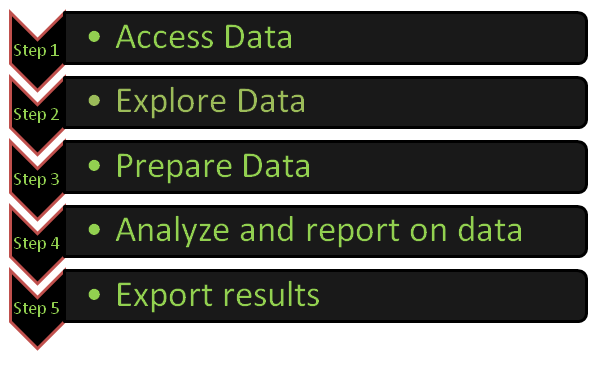Introduction to SAS programming
Last Updated :
30 Sep, 2022
Statistical Analysis System (SAS) is a software suite that has been developed by SAS Institute, one of the leaders in analytics. It is useful for performing advanced analytics, multivariate analyses, business intelligence, data management functions, and also for conducting predictive analytics.
Use of SAS:
SAS is used by many top organizations which include Google, Facebook, Twitter and Accenture for answering the many questions which persist at a business and organizational level and is also used for generating informative reports. It helps in business forecasting, quality improvement, operations research and project management. It is particularly useful in applications development and graphics design. This article should help you get an intuition about the working of SAS applications and a hint about it's raw power.
Types of SAS software:
There are various types of SAS software that are available.In general there are 4 types of SAS software which are given below.
- SAS for Windows
- SAS EG (Enterprise Guide)
- SAS Enterprise Miner (EM)
- SAS Stat Software
The most used software among the above types is SAS for Windows. It can be easily deployed and allows for modernization of your SAS environment by enabling grid processing.
SAS Libraries:
Libraries are the storage mechanisms in SAS. It can store the programs which can be similar in nature. Broadly speaking there are 2 types of libraries viz. temporary and permanent. Temporary libraries are those that exist only during the current SAS session or job. Permanent libraries, as the name suggests are stored in the external storage and are not deleted at the end of a session.
SAS programming workflow:
SAS programming applications are characterized by the flow control specified in the below diagram. 
In the first phase of the above diagram a SAS program will read the data which is usually stored as worksheets in an Excel Workbook. A connection to the workbook is made in this phase and the data is imported in a format suitable for usage in the following phases.
Explore Data:
In the second phase we check for inconsistencies or incorrect values. Here frequency reports and summary statistics may also be generated. Looking at these reports and summaries at first glance we might find some inconsistencies right off the bat. For example all the label names of a categorical attribute except for one might be in capitalized letters. Another example of an incorrect value is a negative value for the minimum number of runs scored by a batsman during a string of matches. The first 5 rows are also shown in this phase.
Prepare Data:
In this phase the issues found in the earlier phase are fixed. Here we create new columns with existing values or concatenate them. Conditional processing is also done in this phase. Certain tables are also joined to provide more consistent representations of data. These tables have clean and validated values.
Analyze and Reporting on data and exporting the results:
The last two phases are combined into one in SAS programming applications. Here we create maps based on geographical coordinates, summary statistics etc. which are some of the output models used for displaying results. We can also save the output models created in an Excel Workbook and download it for later offline use.
Also, there are 200+ components present in SAS, Some popular components are:
- Base SAS
- SAS/GRAPH
- SAS/STAT
- SAS/INSIGHT
- SAS/PH
- SAS/ETS etc.
This is the overall framework of a SAS programming application. Hope this article helps you to get a clear view of the workflow of a SAS program.
Similar Reads
8 Coding Style Tips for R Programming R is an open-source programming language that is widely used as a statistical software and data analysis tool. R generally comes with the Command-line interface. R is available across widely used platforms like Windows, Linux, and macOS. Also, the R programming language is the latest cutting-edge to
5 min read
Blog | Programming Guidelines Computer programming is a process of writing an executable computer program for accomplishing a specific computer task. Although writing the programs is an art, however, there should be some minimum guidelines that should be followed while writing programs. Name: Define the variable names as per pro
2 min read
C Programming For Beginners - A 20 Day Curriculum! For the last 40-45 years, C is one of the most popular and highly recognized programming languages in the world. In fact, it is the first programming language of a huge number of individuals (including me!). Indeed, it is strongly recommended to start your programming journey with C language as it h
7 min read
How to Start Learning DSA? In the journey of programming, every programmer comes across a point where they want to solve a problem in a more efficient way. While finding a way out of this, they eventually come to know about the term DSA. Now, before jumping into how to start learning DSA, let us first know what the term DSA a
13 min read
Best Books to Learn Data Science for Beginners and Experts Data Science is the most revolutionary field in the tech industry these days! All companies, whether they are small businesses or tech giants, use data to understand market trends and retain their competitive edge. And since more and more companies are using data science, there is an increasing dema
6 min read
7 Best Books for Learning SQL SQL (Structured Query Language) is a powerful and widely used programming language for managing relational databases. As a database administrator, developer, or data analyst, having a solid understanding of SQL is essential for managing and analyzing data effectively. With the ever-growing importanc
6 min read